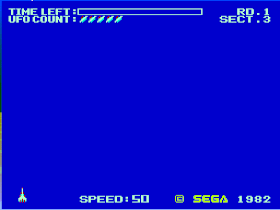Zoom 909, released internationally as Buck Rogers: Planet of Zoom (with zero connections to the long running multimedia franchise except the cabinet artwork), is the second Sega whale, and takes 3D perspective to the next level, offering a speedy third person perspective with parallax scrolling starfields in the space stages, convincing 3D terrain and obstacles in planet surface and trench stages, and some not so convincing sprite scaling effects everywhere. This isn't the first game to offer this kind of perspective, but no such game before it has been so steadily fast, or had so much stuff going on at once. This is very much an ahead of its time game, which isn't really a good thing.
Planet of Zoom plays like a rail shooter, though your relative freedom of movement depends on the stage type. Space zones control like Star Fox, with free up-down-left-right movement, but your general direction is ever forwards-moving. Trench stages are largely about lateral manuevers to avoid obstacles, with very limited up and down movement. Planet surface stages allow turning in any direction, though there's nothing on these planets to make them worth exploring. All stages allow you to adjust your engine speeds in a range from 1 to 99, but this ability is easily forgotten.
The pseudo-3D graphics are powered by an upgraded version of the PCB that powered Sega's Turbo in 1981, now running at 60fps instead of 30, with 1024 onscreen colors, and a 512 pixel wide resolution. The sprite scaling, unfortunately, is this game's Achilles heel. Unlike Turbo, where objects were always on the road, Zoom's got free-flying objects of every altitude zipping about all over the place, and consequently the game's representation of 3D space makes no sense at all.
Sprites routinely overlap your spaceship when they should be in the distance. Even shadows of the enemy ships, seen during trench and planet surface stages, will overlap your ship. The schizophrenic 3D collision detection allows you to pass right through some obstacles, while others will kill you for being in the same time zone, and judging objects' depths is impossible even in the stages where they cast shadows on the ground. In the above shot, just how big are those space mines anyway? Are they just utterly ginormous, or did I get hit by one in the foreground? In most of the stages you can also forget about shooting enemies accurately; just keep firing and you'll hit what you hit.
Make it to the eighth sector, and you fight a very large but pathetically easy boss, if your brain can handle the nonsensical perspective where your ship and your missiles are drawn behind it despite also being in front of it.
Sega's "VCO Object" hardware, used for the last time in this game, supposedly involves analog sprite scaling circuitry, but that could have fooled me. Sprites do not scale smoothly, but "step" through a small number of discrete sizes. This is extremely obvious in the boss stage, but evident with all sprites except for explosions, which do scale smoothly. I thought at first this might be an emulation issue, but video footage of real hardware shows this is accurate.
Zoom is one of few arcade games of its time that allow continuing from your current location on a game over. Unusually, continuing does not reset your score, making a high score achievement completely pointless. Anyone, with enough quarters, can get a high score no matter how badly they play. It doesn't take very long to flip the score counter either; I managed on round three.
GAB rating: Below Average. Planet of Zoom might be historically important, and its presentation may be unprecedented, but like its hardware predecessor Turbo, it does not play well at all. I'd go as far as to call it mechanically broken, and perhaps saved from a Bad rating only by merit of being a rather easy game, which isn't good, but I'd rather a game be too easy than be hard for the wrong reasons.



This has to be the progenitor of Space harrier and Panzer Dragoon,right?
ReplyDeleteProbably? Wikipedia states that it influenced Space Harrier, and that Space Harrier in turn influenced Star Fox. I haven't played Space Harrier or read anything about its development, but I have no doubts at all that Star Fox influenced Panzer Dragoon, or that Panzer Dragoon influenced Star Fox 64.
Delete"...my first exposure to the company name was through the Sega Genesis, which to me was basically an upgraded NES..."
ReplyDeleteSomewhere a Sega Master System cried a single tear no one noticed.
Funnily enough, I did see a Master System exactly one time prior to owning a Genesis, but the name "Sega" meant nothing to me and if I even saw it on screen, it didn't register at all. It wasn't until a good year or two after owning a Genesis that I realized the Master System was its direct predecessor.
Delete